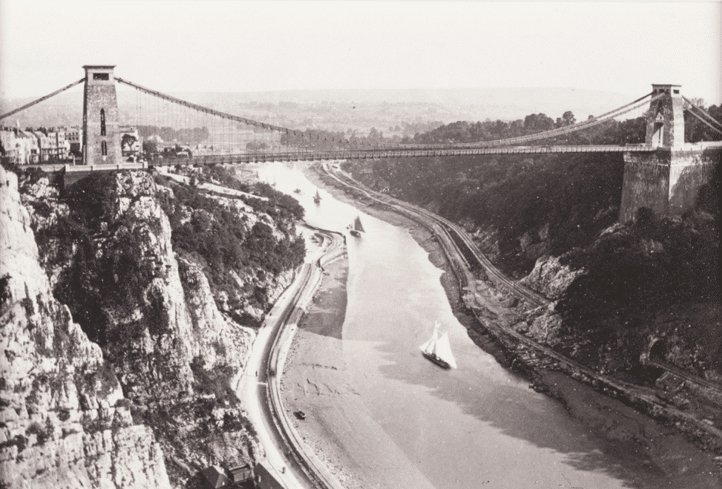Episode 86: Sarah Guppy
Sarah Maria Beach was born in Birmingham, England on November 5, 1770. Her father was a wealthy merchant who traded in brass and sugar. On February 22, 1795 she married Samuel Guppy, a merchant from Bristol, where they settled. Sarah had 6 children from 1795-1809. Samuel was an inventor and in 1804 he took out a patent for copper sheathed nails that could be counter sunk into the hull of a ship. The Admiralty was interested in this patent and Sarah helped negotiate the contract to make the family around 20-40 thousand pounds. Sarah was a savvy businesswoman who was helping Samuel run his operations. In March 1811, Sarah took out a patent for a ‘new mode of constructing and erecting bridges and rail-roads without arches or sterlings, whereby the danger of their being washed away by floods is avoided’. It’s commonly referred to as a ‘chain bridge’ or a ‘hanging bridge’. Sarah is thought to be inspired by the need to build a bridge across the Avon Gorge in Bristol. The Clifton Suspension Bridge would eventually be built across the gorge and was designed by Isambard Kingdom Brunel. Sarah didn’t design the eventual bridge, but was a huge supporter of it and helped raise money and support for it’s construction. In March 1812, Sarah pulled another patent for a tea and coffee urn that could also poach eggs and keep toast warm. In 1830 Samuel passed away. In 1831 Sarah took out a patent for the design of a bed that had underbed storage drawers, a built-in exercise machine, and features 'intended to reduce dust collection and improve ventilation’. On January 29, 1837, Sarah got remarried to Charles Eyre Coote. Sadly he was a gambler and proceeded to gamble her money away, so she separated from him. She continued to invent and registered eight new designs under the Copyright and Design Act of 1839. Sarah Coote died at her house in Bristol on August 24, 1852. She was 81 years old and at the time of her death she only had 200 pounds to her name.
Simple Picture of Sarah’s Chain Bridge: https://twitter.com/markhipwell1990/status/1415943659002925058
Caryatid: Dr. Priti Parikh
Priti studied structural engineering and urban planning in India. Her dad was a structural engineer and inspired her to go into the profession. She worked as an engineer for 12 years both in India and the UK before deciding to get her doctorate from the University of Cambridge. At Cambridge she focused on infrastructure in the impoverished areas of both India and South Africa. Doing her doctorate made her realize she loved researching and how it can better inform design and therefore help resource-challenged communities. After her doctorate she began teaching at the Bartlett School of Sustainable Construction as an Associate Professor and leads the Engineering for International Development Research Centre there.
References
Dresser, Madge. "Guppy [née Beach; other married name Coote], Sarah (bap. 1770, d. 1852), inventor." Oxford Dictionary of National Biography. October 06, 2016. Oxford University Press. Date of access 2 Sep. 2023, <https://www.oxforddnb.com/view/10.1093/ref:odnb/9780198614128.001.0001/odnb-9780198614128-e-109112>
Higgitt, Rebekah. “Uncovering the Lives of Women in Science and Technology: The Case of Sarah Guppy.” The Guardian, 8 June 2016, www.theguardian.com/science/the-h-word/2016/jun/08/revealing-lives-women-science-technology-history-sarah-guppy. Accessed 10 July 2023.
Pollard, Justin. “The Eccentric Engineer: Sarah Guppy.” E&T Magazine, 16 Oct. 2021, eandt.theiet.org/content/articles/2021/10/the-eccentric-engineer-sarah-guppy. Accessed 10 July 2023.
“Professor Priti Parikh.” ICE, www.ice.org.uk/what-is-civil-engineering/who-are-civil-engineers/professor-priti-parikh. Accessed 21 July 2023.
“Sarah Guppy.” ICE, www.ice.org.uk/what-is-civil-engineering/who-are-civil-engineers/sarah-guppy.
“Sarah Guppy an English Inventor.” Intriguing History, 22 Feb. 2016, intriguing-history.com/sarah-guppy-english-inventor.
Wikipedia contributors. “Sarah Guppy.” Wikipedia, July 2023, en.wikipedia.org/wiki/Sarah_Guppy.


